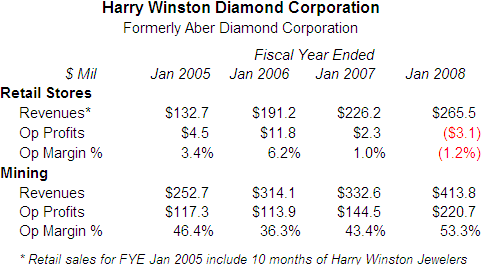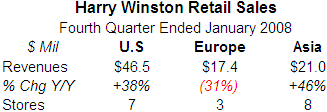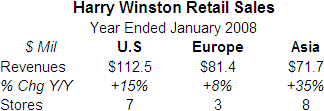IDEX Online Research: Harry Winston: Uber-Luxury Jewelry Sales Don’t Necessarily Mean Big Profits
May 22, 08
Harry Winston Diamond Corporation’s 2008 annual report to shareholders highlights one of its key strategies: “The company focuses on the two most profitable segments of the diamond industry, mining and retail, in which its expertise creates shareholder value.” While we agree with this statement conceptually, there is a problem: the retail segment of the company’s business – world premier retail jeweler Harry Winston – doesn’t seem to be contributing to that strategy.
In the year just ended (January 2008), Harry Winston’s retail stores posted an operating loss for the full year – $3.1 million on sales of $265.5 million, or a net operating loss on sales of 1.1 percent. Further, for the all-important fourth quarter, the retail division, generated an operating loss of $1.5 million on sales of $85.0 million. For the prior year (12 months ended January 2007), Harry Winston’s retail stores generated a disappointing operating profit of just $2.2 million, or 1.0 percent of sales of $226.2 million. By contrast, Tiffany & Co. generated an operating margin of 18.0 percent for its fiscal year ended January 2008, up from 16.8 percent in the prior year. A typical specialty jeweler should generate an operating profit of 10 percent or so of sales.
As for Harry Winston’s mining segment, it is clearly carrying the company. Its revenues are about 61 percent of total corporate revenues, and its profits are dramatic: on sales of about $414 million (its share of rough diamond revenue from Diavik, a partnership with Rio Tinto), its operating profits were nearly $221 million last year, or about 53 percent of revenues.

Source: Company Reports
The table below summarizes sales and operating profits by operating division for the past several years:
 Source: Company Reports |
What’s Wrong With Retail?
Harry Winston is certainly one of the best-known uber-luxury jewelers in the world. It doesn’t run sales; it has no gross margin pressure from competition. Shoppers can’t compare prices, because it carries unique items. While other jewelers moan and groan about how bad business is, Harry Winston continues to post double-digit sales gains. But its profits were dismal in 2006, and vanished in 2007 (year ended January 2008). Since they were acquired by Harry Winston Diamond Corporation (formerly Aber Diamond), they have never been on par with the rest of the jewelry industry. What is wrong with this picture?
With such a disparity between sales gains and diminishing profits, many companies would have brought in new management. But that hasn’t happened, at least at the top of the Harry Winston retail division.
Unfortunately, management doesn’t provide much information about the disappointing performance of its Harry Winston retail division. Though it is based in Canada, the company provides results in U.S. dollars (probably an unwise decision, given the current weakness of the greenback, but one that cannot be blamed on management). Further, because the stock trades in the U.S., it files certain legal documents with the Securities and Exchange Commission. That’s the rub: foreign filers are not required to provide as much detail as companies domiciled in the U.S. Despite the lack of detail, we were able to glean these highlights from the most recent fiscal year ended January 2008 for the retail division’s 18-store operation. We note that there are some modest wholesale revenues in these results, but the company provides no breakdown of those sales.
- Gross margin down modestly – The retail division’s gross margin contracted by about 90 basis points to 46.7 percent due to continued margin pressure related to clearing pre-acquisition inventory (that inventory is now over four years old; most jewelers melt old inventory when it is two years old).
- Operating Costs Up Somewhat – Operating costs rose 130 basis points to 47.9 percent of sales due to expenses related to five new stores and refurbishing two older stores, as well as disruptions related to a robbery of $23.2 million of goods from its Paris store in the third quarter of 2007. The only good news is that Harry Winston was fully insured for its loss in the robbery. Management did not break out the estimated negative financial impact of the robbery, and the other factors which hurt earnings really weren’t significant.
The problem is obvious, though: none of these trends are back-breaking. They just don’t adequately explain what is going on in the retail division.
Further, despite the negative impact of the retail division’s costs, sales were up solidly: +17 percent for the year and +16 percent in the fourth quarter. During the year, the company added five new stores, and ended the year with 18 units. As a result, sales per store were only $4.7 million in the fourth quarter of 2007, down 16 percent from the prior year’s $5.6 million sales per store. These five immature stores and their lower sales per store clearly had a negative impact on the efficient absorption of relatively fixed overhead expenses. On an annual basis, sales per store were about $14.8 million in 2008, down 15 percent from the prior year. This was to be expected, due to the fact that a third of its stores are a year or less old.
Even worse, the four-year trend for the Harry Winston retail division earnings has been dismal. This chain, which consisted of six stores at the time, was acquired by Aber Diamond (which has since changed its name to Harry Winston Diamond) in April 2004. Operating earnings were solid in the year ended January 2005, and up sharply in 2006. Since then, there has been a dramatic deterioration in profits, despite solid sales gains (see earlier table).
Harry Winston Retail Background
Aber Diamond Company purchased Harry Winston jewelers in April of 2004; at the time, Harry Winston operated six stores worldwide. Because the Harry Winston name has such broad global recognition, Aber Diamond Corporation changed its corporate name to Harry Winston Diamond Corporation late in 2007. Last year, the company derived 39 percent of its revenues from the retail division (Harry Winston Jewelers) and the balance from its 40 percent undivided ownership of the Diavik diamond mine in Canada, jointly operated with Rio Tinto.
Harry Winston currently operates 18 salons in key locations around the world including New York, Paris, London, Beijing, Tokyo, and Beverly Hills. Seven of its 18 units are in the U.S., three in the European Union, and eight in the Far East. Harry Winston timepieces are also sold through a network of independent distributors.
In its annual report to shareholders, management states “The company focuses on the two most profitable segments of the diamond industry, mining and retail, in which its expertise creates shareholder value. his unique business model provides key competitive advantages; rough diamond sales and polished diamond purchases provide market intelligence that enhances the company’s overall performance. Moreover, being one of the world’s leading rough diamond suppliers enables the company to use its strong client relationships to secure the highest-quality polished diamonds for its retail division. By linking the production and retailing of diamonds, Harry Winston Diamond Corporation benefits from the market synergy created between rough diamond producer, polished diamond buyer, and retailer of fine jewelry.” We agree wholeheartedly with this philosophy and strategy; the problem is that the current financials don’t support this theory.
Harry Winston’s merchandise for its retail division is created and supplied from its own design and manufacturing workshop located above the New York salon on Fifth Avenue. These goods are supplemented by consignments of gemstones and jewelry from third parties. The company also out-sources the production of certain jewelry, when costs and production requirements warrant. Its diamonds come from the Diavik mine as well as other rough and polished diamond suppliers.
Harry Winston’s new watch factory, located in Geneva, Switzerland, began operations in October 2007; it has enough capacity to meet demand for the foreseeable future for both the company’s retail division and its wholesale customers.
Harry Winston’s View of the Diamond Market
As Harry Winston management correctly reports in its public documents, rough diamond prices remained strong throughout 2007. It noted that the upward trend in prices was particularly evident in the larger, better-quality diamonds. This positive growth was also evident in smaller, high-quality rough diamonds driven by demand from the watch industry.
During 2007, the diamond market showed strong sales growth in China, India, and the Middle East, which was offset by diminished demand in the U.S.
Harry Winston’s Results by Geographic Region
Fourth Quarter
Sales in the all-important fourth quarter, a period in which Harry Winston generates about 32 percent of its annual retail revenues (versus about 38 percent of revenues for the typical specialty jeweler), were up in the U.S. and Asian markets, but down in the company’s European markets. Management explained that while sales to Europeans were very strong, they did not shop locally. Instead, many of them came to the U.S. to shop for jewelry due to the strong Euro versus the weak U.S. dollar. For the three-month period, sales in the Harry Winston retail division were up 16 percent.
The table below summarizes fourth quarter sales by major geographic region for Harry Winston:

Source: Company Reports
While the company does not disclose same-store sales, we believe they were up only very modestly in the fourth quarter. Management said most of the sales increase was due to the opening of two new stores in the period.
Harry Winston’s retail gross margin in the fourth quarter fell modestly to 45.1 percent of sales from 46.6 percent in the prior year. If the sale of pre-acquisition inventory had been removed (goods roughly four years old and older), the company’s retail gross margin would have been 47.4 percent of sales versus 51.8 percent in the prior year. The company made two very large low-margin sales in the period. One of those sales was made into the Russian market, and involved a large number of jewelry items; the company took a lower-than-average margin on the sale in order to boost awareness of the Harry Winston brand in the market.
Operating costs in the fourth quarter were 46.9 percent of sales, up sharply from last year’s 42.6 percent of sales due primarily to expenses related to the opening of two new stores as well as disruptions related to the third quarter Paris robbery.
Full Year
For the full year ended January 2008, sales results showed less volatility. The table below summarizes full year sales trends for the Harry Winston retail jewelry division:

Source: Company Reports
The retail division posted an annual gross margin of 46.7 percent versus 47.6 percent of sales in the prior year. If pre-acquisition inventory sales were removed, the company’s gross margin would have been 50.3 percent versus 50.7 percent. The company offered no explanation of these gross margin trends. We believe that wholesale sales may have been greater in the most recent year; further, there could have been other sales mix issues which had a negative impact on gross margins.
Operating costs were 47.9 percent of sales, up from the prior year’s 46.6 percent, mainly due to expenses related to new store openings. In addition, the impact of consolidating its watch operations in Geneva had a negative impact on costs.
Management’s Outlook for Harry Winston Retail Division
Management noted in its annual report that the high-end luxury goods industry has historically been more resilient to economic fluctuations. With its geographically diverse store base, Harry Winston should be especially insulated from economic cyclicality. Management said that demand volatility in the U.S. markets related to the financial markets is expected to be offset by continued strong demand for high-end diamond jewelry and watches from markets like China, Russia, and the Middle East in 2008.
The company will continue to support its expanded store network and introduce new limited hand-crafted jewelry designs using the highest quality diamonds during 2008. New jewelry collections will be introduced.
After opening five stores in 2007, the company plans to open only one unit in 2008, in Costa Mesa, California (South Coast Plaza in Orange County). Management says it will focus on improving productivity and operating efficiencies at its existing stores.
Management says it expects to generate record double-digit sales growth and strong underlying gross margins, resulting in an improvement in earnings from retail operations during 2008.
Management noted that its stock price was under pressure in 2007. It concluded that the equity market took the view that luxury products, including diamonds, would suffer from the U.S. downturn. Management said, “This is too broad an analysis. Our own sales in important markets outside of the U.S. have continued to strengthen. We’ve doubled sales to Russian customers this year, for example.”
Management also noted that customers are demanding colored diamonds, blues and pinks in particular.
In a recent diamond tender, Harry Winston said that demand is being driven by polished diamonds that are whitish – better than J in color – as well as SI2 and better clarity, and larger in size. Diamonds that Americans seem to buy – brownish in color – reflect slackened demand.
The company continues to seek new markets. Management commented, “India is a market on which we are focusing for the future. We already have a diamond sourcing and sorting facility in Mumbai, and we are eager to expand into the retail business when the right opportunity is identified.”